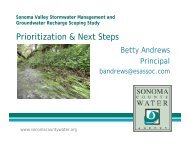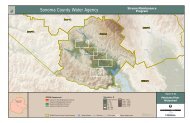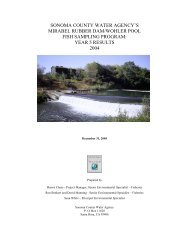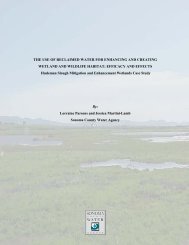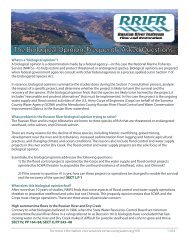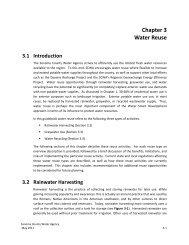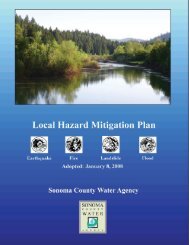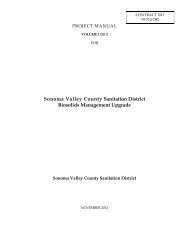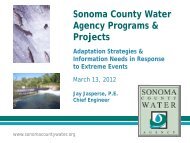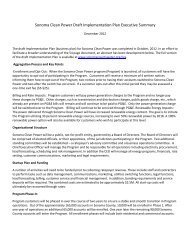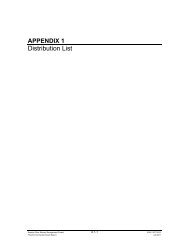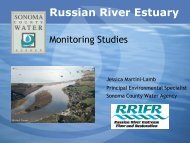Hydrography of the Russian River Estuary - Sonoma County Water ...
Hydrography of the Russian River Estuary - Sonoma County Water ...
Hydrography of the Russian River Estuary - Sonoma County Water ...
You also want an ePaper? Increase the reach of your titles
YUMPU automatically turns print PDFs into web optimized ePapers that Google loves.
3. Data Analysis<br />
The results from several analyses are reported in this section. A full representation <strong>of</strong><br />
<strong>the</strong> data is available in <strong>the</strong> companion data report (Behrens & Largier 2010). Here we<br />
address specific issues:<br />
(1) An estimate is obtained for water lost as seepage through <strong>the</strong> sand barrier at <strong>the</strong><br />
mouth by calculating a budget <strong>of</strong> water flow into and out <strong>of</strong> <strong>the</strong> estuary.<br />
(2) Tidal flows and diurnal wind-driven seiche flows are quantified through an analysis <strong>of</strong><br />
data on current velocities and water level fluctuations.<br />
(3) The spatial distribution <strong>of</strong> salinity is described, specifically addressing intrusion <strong>of</strong><br />
salinity upstream during open and closed periods.<br />
(4) The spatial distribution <strong>of</strong> water temperature is described and changes during <strong>the</strong><br />
long closure event are outlined.<br />
(5) The spatial distribution <strong>of</strong> dissolved oxygen is described, identifying locations and<br />
times when anoxic or hypoxic conditions are found at depth.<br />
(6) Stratification is quantified and analysis <strong>of</strong> <strong>the</strong> stability <strong>of</strong> this stratification provides a<br />
measure <strong>of</strong> <strong>the</strong> likelihood <strong>of</strong> mixing between deep saline water and surface freshwater.<br />
(7) A salt budget is calculated for <strong>the</strong> long closure event.<br />
(8) An oxygen budget is calculated for <strong>the</strong> lower layer.<br />
3.1 – <strong>Water</strong> budget & Seepage analysis<br />
At <strong>the</strong> heart <strong>of</strong> <strong>the</strong> NMFS-proposed management protocol for <strong>the</strong> <strong>Russian</strong> <strong>River</strong> estuary<br />
is <strong>the</strong> concept that water will escape from a closed estuary by seeping through <strong>the</strong> sand<br />
barrier that separates it from <strong>the</strong> ocean. This will happen due to <strong>the</strong> rise <strong>of</strong> <strong>the</strong> elevation<br />
<strong>of</strong> <strong>the</strong> estuary water level above that in <strong>the</strong> ocean (i.e., a scenario typically described as<br />
a “perched lagoon”). This “seepage loss” may be accompanied by a flow <strong>of</strong> water over<br />
<strong>the</strong> sand barrier (which is also known as <strong>the</strong> “berm”, referring to its wave-built origin).<br />
Such an “overflow” at <strong>the</strong> mouth <strong>of</strong> <strong>the</strong> <strong>Russian</strong> <strong>River</strong> is not common in recent times<br />
(PWA 2009), and <strong>the</strong> future flow rate is expected to be much lower than typical river<br />
inflow rates in <strong>the</strong> past, even in dry years, so that a significant seepage loss is required<br />
to maintain a steady water level in <strong>the</strong> estuary. Both overflow and expulsion <strong>of</strong> deeper<br />
saline waters through <strong>the</strong> sand barrier occur in comparable smaller estuaries along <strong>the</strong><br />
coast <strong>of</strong> California, as noted in NMFS (2008).<br />
13




